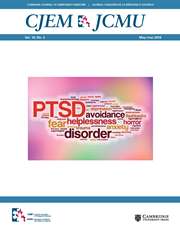Original Research
A National Faculty Development Needs Assessment in Emergency Medicine
-
- Published online by Cambridge University Press:
- 09 September 2015, pp. 161-182
-
- Article
-
- You have access
- HTML
- Export citation
Ultrasound during Critical Care Simulation: A Randomized Crossover Study
-
- Published online by Cambridge University Press:
- 26 August 2015, pp. 183-190
-
- Article
-
- You have access
- HTML
- Export citation
Cost-effectiveness of a physician-nurse supplementary triage assessment team at an academic tertiary care emergency department
-
- Published online by Cambridge University Press:
- 04 September 2015, pp. 191-204
-
- Article
-
- You have access
- HTML
- Export citation
Predictors of posttraumatic stress and preferred sources of social support among Canadian paramedics
-
- Published online by Cambridge University Press:
- 01 September 2015, pp. 205-212
-
- Article
-
- You have access
- HTML
- Export citation
A Survey to Determine Decision-Making Styles of Working Paramedics and Student Paramedics
-
- Published online by Cambridge University Press:
- 02 February 2016, pp. 213-222
-
- Article
-
- You have access
- HTML
- Export citation
Editorial/Commentary
What is new in the 2015 American Heart Association guidelines, what is recycled from 2010, and what is relevant for emergency medicine in Canada
-
- Published online by Cambridge University Press:
- 03 May 2016, pp. 223-229
-
- Article
-
- You have access
- HTML
- Export citation
Brief Educational Report
Queen’s University Emergency Medicine Simulation OSCE: an Advance in Competency-Based Assessment
-
- Published online by Cambridge University Press:
- 20 May 2015, pp. 230-233
-
- Article
-
- You have access
- HTML
- Export citation
Resident Issues
Lessons in every patient encounter
-
- Published online by Cambridge University Press:
- 18 May 2015, p. 234
-
- Article
-
- You have access
- HTML
- Export citation
Knowledge to Practice
Lorazepam v. diazepam for pediatric status epilepticus
-
- Published online by Cambridge University Press:
- 06 July 2015, pp. 235-238
-
- Article
-
- You have access
- HTML
- Export citation
Using baby oil to remove asphalt from burn
-
- Published online by Cambridge University Press:
- 03 August 2015, pp. 239-240
-
- Article
-
- You have access
- HTML
- Export citation
Humour and Humanity
Helpless Healer
-
- Published online by Cambridge University Press:
- 03 May 2016, pp. 241-242
-
- Article
-
- You have access
- HTML
- Export citation
Erratum
Hypertonic saline in severe traumatic brain injury: a systematic review and meta-analysis of randomized controlled trials – ERRATUM
-
- Published online by Cambridge University Press:
- 18 April 2016, p. 243
-
- Article
-
- You have access
- HTML
- Export citation
Front Cover (OFC, IFC) and matter
CEM volume 18 issue 3 Cover and Front matter
-
- Published online by Cambridge University Press:
- 03 May 2016, pp. f1-f3
-
- Article
-
- You have access
- Export citation



